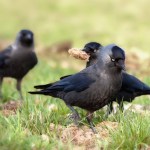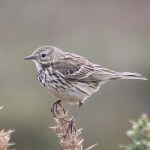 – Size: 44.6ha, of which 38.33ha is a designated SSI.
– Size: 44.6ha, of which 38.33ha is a designated SSI.
– Main habitat types: dwarf shrub heath, maritime rock/cliff ledge community, mature gorse, bare rock, bracken, maritime heath, mixed scrub, pioneer coastal community, woodland, old agricultural field, and others.
The Site of Special Interest (SSI) status of La Lande du Ouest is measured by not only the extent of its ecological importance but also it’s  geological, archaeological and landscape value. The site’s location on the south-west coast of Jersey provides a combination of sun exposure and prevailing south westerly winds to create a typical dry maritime microclimate. The typical coastal heathland is broken up with small open patches providing a suitable mosaic to support a variety of species.
geological, archaeological and landscape value. The site’s location on the south-west coast of Jersey provides a combination of sun exposure and prevailing south westerly winds to create a typical dry maritime microclimate. The typical coastal heathland is broken up with small open patches providing a suitable mosaic to support a variety of species.
There are a number of freshwater features associated with the site including two ponds and several springs or seepages on the cliffs. This hydric system supports several rare plant species like marsh St John’s wort Hypericum elodes and royal fern Osmunda regalis. In addition to the 18 species with Biodiversity Action Plans the site supports an extensive suite of characteristic flora (more than 116 recorded plant species) and fauna for a maritime heathland area. This site is also rich in industrial quarrying archaeology, activity that left a topographic impact on the present landscape and ecological features. The rich soil inland supports agricultural activities.
Birds and other wildlife
 This area plays a major part in preserving the Island’s biodiversity, both through its role linking other coastal heathlands and for its own biodiversity. Birds present include peregrine Falco peregrinus, Dartford warbler Sylvia undata, common whitethroat S. communis, meadow pipit Anthus pratensis, linnet Carduelis cannabina, raven Corvus corax and jackdaw C. monedula. Stonechat Saxicola rubecula, serin Serinus serinus and cirl bunting Emberiza cirlus also formerly bred here. La Lande du Ouest also provides habitat to green lizard Lacerta bilineata, grass snake Natrix natrix, common toad Bufo bufo, red squirrel Sciurus vulgaris, bank vole Myodes glareolus, shrews and bats.
This area plays a major part in preserving the Island’s biodiversity, both through its role linking other coastal heathlands and for its own biodiversity. Birds present include peregrine Falco peregrinus, Dartford warbler Sylvia undata, common whitethroat S. communis, meadow pipit Anthus pratensis, linnet Carduelis cannabina, raven Corvus corax and jackdaw C. monedula. Stonechat Saxicola rubecula, serin Serinus serinus and cirl bunting Emberiza cirlus also formerly bred here. La Lande du Ouest also provides habitat to green lizard Lacerta bilineata, grass snake Natrix natrix, common toad Bufo bufo, red squirrel Sciurus vulgaris, bank vole Myodes glareolus, shrews and bats.
Management
 La Lande du Ouest is very popular with visitors and management needs to be considerate of wildlife and people. The site was neglected in the past, adding to the problems caused by fires which have led to the proliferation of invasive plant species. Gorse, bracken and Hottentot fig are encroaching on to existing maritime communities creating ecological problems that need to be addressed.
La Lande du Ouest is very popular with visitors and management needs to be considerate of wildlife and people. The site was neglected in the past, adding to the problems caused by fires which have led to the proliferation of invasive plant species. Gorse, bracken and Hottentot fig are encroaching on to existing maritime communities creating ecological problems that need to be addressed.
Future management to consider:-
- Removal of bracken and gorse which have encroached onto inland areas, and manage the clearing through grazing regimes: bracken is not well established except around the prison and is mainly in disused fields where most of it should be manageable;
- Removal of Hottentot fig from coastal slopes (often difficult due to topography);
- Re-planting hedgerows around field boundaries;
- Bringing old fields back in to use as grazing or weedy/cereal crops;
- Encouraging areas of longer grass to grow;
- Planting of some tall shrubs;
- Making sure that there are suitable set way-markers to direct public and reduce disturbance of sensitive areas.
There is a leaflet detailing walks at La Lande du Ouest



